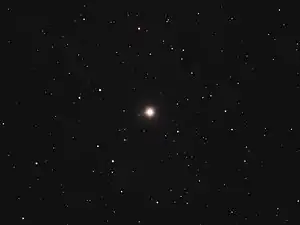Xi Draconis
Xi Draconis (ξ Draconis, abbreviated Xi Dra, ξ Dra) is a double or binary star in the northern circumpolar constellation of Draco. It has an apparent visual magnitude of 3.75.[2] Based upon parallax measurements, it is located at a distance of 112.5 light-years (34.5 parsecs) from the Sun.[1] At this distance, the apparent magnitude is diminished by 0.03 from extinction caused by intervening gas and dust.[4]
 ξ Draconis in optical light | |
| Observation data Epoch J2000 Equinox J2000 | |
|---|---|
| Constellation | Draco |
| Right ascension | 17h 53m 31.72962s[1] |
| Declination | +56° 52′ 21.5143″[1] |
| Apparent magnitude (V) | 3.75[2] |
| Characteristics | |
| Spectral type | K2 III[3] |
| U−B color index | +1.21[2] |
| B−V color index | +1.18[2] |
| Astrometry | |
| Radial velocity (Rv) | −26.38 ± 0.20[4] km/s |
| Proper motion (μ) | RA: 93.82 ± 0.14[1] mas/yr Dec.: 78.50 ± 0.12[1] mas/yr |
| Parallax (π) | 28.98 ± 0.12 mas[1] |
| Distance | 112.5 ± 0.5 ly (34.5 ± 0.1 pc) |
| Absolute magnitude (MV) | +1.06[5] |
| Details | |
| Mass | 1.45 ± 0.17[6] M☉ |
| Radius | 12[7] R☉ |
| Luminosity | 49 ± 4[6] L☉ |
| Surface gravity (log g) | 2.3[7] cgs |
| Temperature | 4,445[6] K |
| Metallicity [Fe/H] | −0.09[7] dex |
| Rotational velocity (v sin i) | 2.3[7] km/s |
| Other designations | |
| Database references | |
| SIMBAD | data |
The two components are designated Xi Draconis A (officially named Grumium /ˈɡruːmiəm/, a traditional name for the system)[8][9] and B.
Nomenclature
ξ Draconis (Latinised to Xi Draconis) is the system's Bayer designation. The designations of the two components as Xi Draconis A and B derive from the convention used by the Washington Multiplicity Catalog (WMC) for multiple star systems, and adopted by the International Astronomical Union (IAU).[10]
It bore the traditional names Grumium. This is a graphic corruption of the Latin Grunnum 'snout',[11] as Ptolemy had described this star as being on the jawbone of the dragon.[8] In 2016, the International Astronomical Union organized a Working Group on Star Names (WGSN)[12] to catalogue and standardize proper names for stars. The WGSN decided to attribute proper names to individual stars rather than entire multiple systems.[13] It approved the name Grumium for the component Xi Draconis A on 12 September 2016 and it is now so included in the List of IAU-approved Star Names.[9]
This star was also known as Nodus I or Nodus Primus. Along with Beta Draconis (Rastaban), Gamma Draconis (Eltanin), Mu Draconis (Erakis) and Nu Draconis (Kuma), it was one of Al ʽAwāyd "the Mother Camels", which were later known as the Quinque Dromedarii.[14]
In Chinese, 天棓 (Tiān Bàng), meaning Celestial Flail, refers to an asterism consisting of Xi Draconis, Nu Draconis, Beta Draconis, Gamma Draconis and Iota Herculis.[15] Consequently, the Chinese name for Xi Draconis itself is 天棓一 (Tiān Bàng yī, English: the First Star of Celestial Flail).[16]
Namesake
USS Grumium (AK-112) was a United States Navy Crater-class cargo ship named after the star.
Properties
Xi Draconis A is of spectral class K2-III. The possible companion, Xi Draconis B, is a 16th-magnitude star 316 arcseconds away but, most likely, the pairing is just a line-of-sight coincidence.[17]
References
- van Leeuwen, F. (November 2007), "Validation of the new Hipparcos reduction", Astronomy and Astrophysics, 474 (2): 653–664, arXiv:0708.1752, Bibcode:2007A&A...474..653V, doi:10.1051/0004-6361:20078357, S2CID 18759600.
- Jennens, P. A.; Helfer, H. L. (September 1975), "A new photometric metal abundance and luminosity calibration for field G and K giants.", Monthly Notices of the Royal Astronomical Society, 172 (3): 667–679, Bibcode:1975MNRAS.172..667J, doi:10.1093/mnras/172.3.667.
- Morgan, W. W.; Keenan, P. C. (1973), "Spectral Classification", Annual Review of Astronomy and Astrophysics, 11: 29–50, Bibcode:1973ARA&A..11...29M, doi:10.1146/annurev.aa.11.090173.000333.
- Famaey, B.; et al. (January 2005), "Local kinematics of K and M giants from CORAVEL/Hipparcos/Tycho-2 data. Revisiting the concept of superclusters", Astronomy and Astrophysics, 430 (1): 165–186, arXiv:astro-ph/0409579, Bibcode:2005A&A...430..165F, doi:10.1051/0004-6361:20041272, S2CID 17804304.
- Cardini, D. (January 2005), "Mg II chromospheric radiative loss rates in cool active and quiet stars", Astronomy and Astrophysics, 430: 303–311, arXiv:astro-ph/0409683, Bibcode:2005A&A...430..303C, doi:10.1051/0004-6361:20041440, S2CID 12136256.
- Stello, D.; et al. (2008), "Oscillating K Giants with the WIRE Satellite: Determination of Their Asteroseismic Masses", The Astrophysical Journal Letters, 674 (1): L53–L56, arXiv:0801.2155, Bibcode:2008ApJ...674L..53S, doi:10.1086/528936, S2CID 15094067.
- Massarotti, Alessandro; et al. (January 2008), "Rotational and Radial Velocities for a Sample of 761 HIPPARCOS Giants and the Role of Binarity", The Astronomical Journal, 135 (1): 209–231, Bibcode:2008AJ....135..209M, doi:10.1088/0004-6256/135/1/209, S2CID 121883397.
- Kunitzsch, Paul; Smart, Tim (2006). A Dictionary of Modern star Names: A Short Guide to 254 Star Names and Their Derivations (2nd rev. ed.). Cambridge, Massachusetts: Sky Pub. ISBN 978-1-931559-44-7.
- "Naming Stars". IAU.org. Retrieved 16 December 2017.
- Hessman, F. V.; Dhillon, V. S.; Winget, D. E.; Schreiber, M. R.; Horne, K.; Marsh, T. R.; Guenther, E.; Schwope, A.; Heber, U. (2010). "On the naming convention used for multiple star systems and extrasolar planets". arXiv:1012.0707 [astro-ph.SR].
- In medieval manuscripts, both 'nn' and 'mi' were written with four strokes, ıııı, and thus could be easily confused. (That is why we now dot our i's.) Indeed, both the correct and corrupted spellings would have looked rather like Grııııııııııı.
- IAU Working Group on Star Names (WGSN), International Astronomical Union, retrieved 22 May 2016.
- "WG Triennial Report (2015-2018) - Star Names" (PDF). p. 5. Retrieved 2018-07-14.
- Allen, R. H. (1963), Star Names: Their Lore and Meaning (Reprint ed.), New York, NY: Dover Publications Inc., p. 207, ISBN 0-486-21079-0, retrieved 2010-12-12.
- (in Chinese) 中國星座神話, written by 陳久金. Published by 台灣書房出版有限公司, 2005, ISBN 978-986-7332-25-7.
- (in Chinese) 香港太空館 - 研究資源 - 亮星中英對照表 Archived January 30, 2011, at the Wayback Machine, Hong Kong Space Museum. Accessed on line November 23, 2010.
- Kaler, James B., "GRUMIUM (Xi Draconis)", Stars, University of Illinois, retrieved 2018-02-14